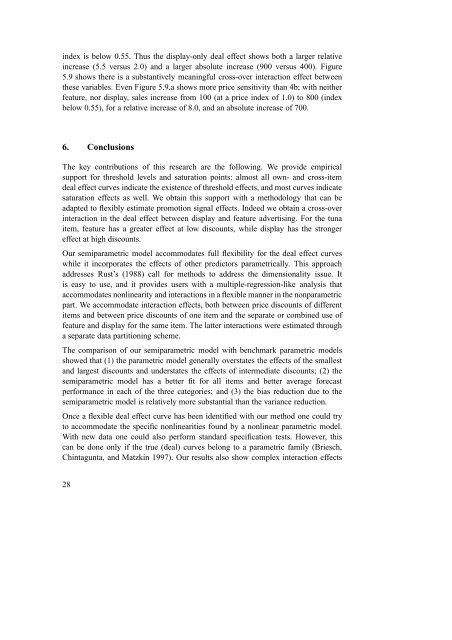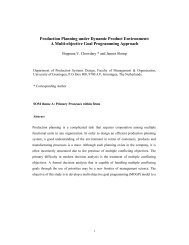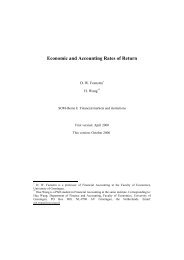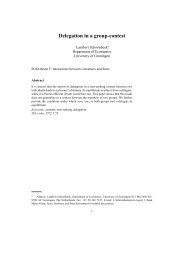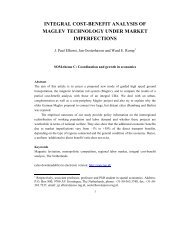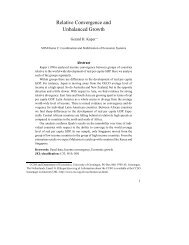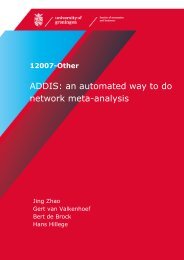Semiparametric Analysis to Estimate the Deal Effect Curve
Semiparametric Analysis to Estimate the Deal Effect Curve
Semiparametric Analysis to Estimate the Deal Effect Curve
You also want an ePaper? Increase the reach of your titles
YUMPU automatically turns print PDFs into web optimized ePapers that Google loves.
index is below 0.55. Thus <strong>the</strong> display-only deal effect shows both a larger relative<br />
increase (5.5 versus 2.0) and a larger absolute increase (900 versus 400). Figure<br />
5.9 shows <strong>the</strong>re is a substantively meaningful cross-over interaction effect between<br />
<strong>the</strong>se variables. Even Figure 5.9.a shows more price sensitivity than 4b; with nei<strong>the</strong>r<br />
feature, nor display, sales increase from 100 (at a price index of 1.0) <strong>to</strong> 800 (index<br />
below 0.55), for a relative increase of 8.0, and an absolute increase of 700.<br />
6. Conclusions<br />
The key contributions of this research are <strong>the</strong> following. We provide empirical<br />
support for threshold levels and saturation points: almost all own- and cross-item<br />
deal effect curves indicate <strong>the</strong> existence of threshold effects, and most curves indicate<br />
saturation effects as well. We obtain this support with a methodology that can be<br />
adapted <strong>to</strong> flexibly estimate promotion signal effects. Indeed we obtain a cross-over<br />
interaction in <strong>the</strong> deal effect between display and feature advertising. For <strong>the</strong> tuna<br />
item, feature has a greater effect at low discounts, while display has <strong>the</strong> stronger<br />
effect at high discounts.<br />
Our semiparametric model accommodates full flexibility for <strong>the</strong> deal effect curves<br />
while it incorporates <strong>the</strong> effects of o<strong>the</strong>r predic<strong>to</strong>rs parametrically. This approach<br />
addresses Rust’s (1988) call for methods <strong>to</strong> address <strong>the</strong> dimensionality issue. It<br />
is easy <strong>to</strong> use, and it provides users with a multiple-regression-like analysis that<br />
accommodates nonlinearity and interactions in a flexible manner in <strong>the</strong> nonparametric<br />
part. We accommodate interaction effects, both between price discounts of different<br />
items and between price discounts of one item and <strong>the</strong> separate or combined use of<br />
feature and display for <strong>the</strong> same item. The latter interactions were estimated through<br />
a separate data partitioning scheme.<br />
The comparison of our semiparametric model with benchmark parametric models<br />
showed that (1) <strong>the</strong> parametric model generally overstates <strong>the</strong> effects of <strong>the</strong> smallest<br />
and largest discounts and understates <strong>the</strong> effects of intermediate discounts; (2) <strong>the</strong><br />
semiparametric model has a better fit for all items and better average forecast<br />
performance in each of <strong>the</strong> three categories; and (3) <strong>the</strong> bias reduction due <strong>to</strong> <strong>the</strong><br />
semiparametric model is relatively more substantial than <strong>the</strong> variance reduction.<br />
Once a flexible deal effect curve has been identified with our method one could try<br />
<strong>to</strong> accommodate <strong>the</strong> specific nonlinearities found by a nonlinear parametric model.<br />
With new data one could also perform standard specification tests. However, this<br />
can be done only if <strong>the</strong> true (deal) curves belong <strong>to</strong> a parametric family (Briesch,<br />
Chintagunta, and Matzkin 1997). Our results also show complex interaction effects<br />
28


